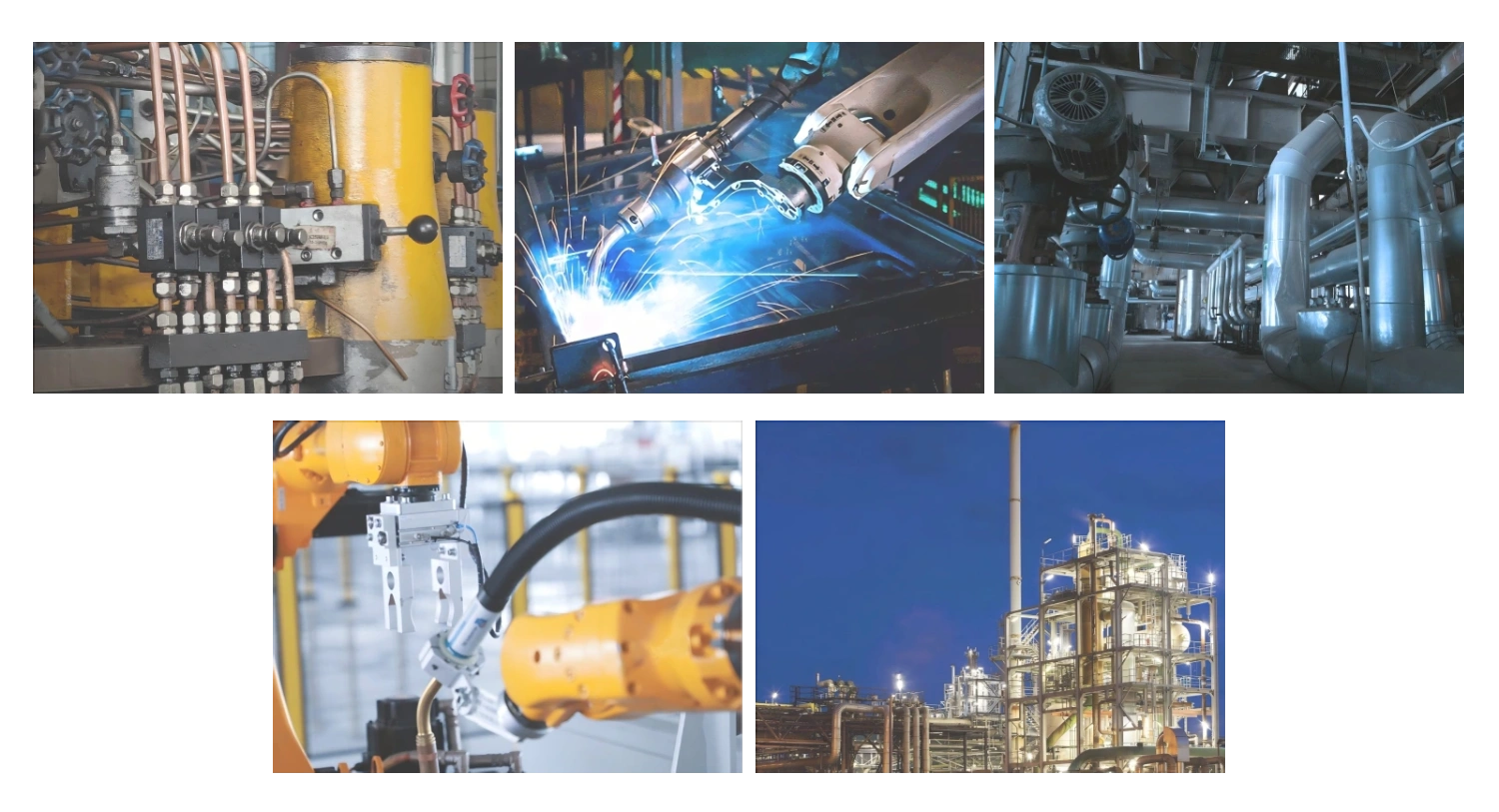NBR vs FKM vs EPDM: Core Material Properties
Nitrile (NBR): Oil Resistance and Limitations
Nitrile (NBR) possesses an extraordinary resistance to oils, and an optimum choice for hoses used in oil and fuel systems in automotive and industrial sectors. This rubber is made up of 30%-50% butadiene and 50%-70% acrylonitrile and that’s why they are oil-resistant and possess the high tensile strength. But I have to note that NBR has weaknesses that can be problematic; it is more vulnerable to swelling when in contact with some chemicals, especially polar solvents, and this in turn can jeopardize the sealing performance.
Fluorocarbon (FKM): High-Temperature Performance
Fluorocarbon elastomers (FKM) are intended to provide a high temperature tolerance and superior performance in many aerospace and industry applications. This capability makes FKM best suited for automotive and aerospace applications, as well other high performance applications. Awesome resistance to solvents and fuels (maintains stability through wide range of temperatures) Ideal for use on engines. The characteristics of FKM make it ideal for applications that require resistance to high temperature and/or aggressive chemicals, such as tough sealing, conveyance implementation, and aggressive media transfer.
EPDM: Weathering and Steam Compatibility
EPDM performs above standard outdoors, offering exceptional weathering and UV resistance—essential traits for parts used in the elements. EPDM is suitable for steam applications, such as steam valves that experience high temperatures and wet conditions. With an operating temperature range between -40°C and 120°C, EPDM performs well with outdoor applications, while the chemical resistance provides durability and flexibility; this can also be used for the agricultural, food, health care, construction and many other industries.
Temperature Resistance Comparison
Operational Range: -50°C to 204°C Breakdown
Temperature dependence of different rubber compounds shows their distinct operating temperatures. For example, NBR fares.Indeed, very well in the cold, so maintaining its flexibility and strength in temperatures as low as -50°C, it is therefore perfect for if you are working in low temperature environments or in cold climates. Meanwhile, EPDM excels in mild heat, managing temperatures of up to 120°C with relative ease, so proving to be a bit of a general dabbler for applications including automotive and industrial seals. Differently (FKM FKM, On the other hand, no other material can compare with FKM for high temperature resistance: It functions well even at 204°C and also stands up well at low temperatures. This flexibility demonstrates just how well-suited DSAs can be for high-performance industries like aerospace. Trustworthy producers provide specific thermal properties and use this information to select the correct material, helping customers achieve accuracy and speed for various applications.
Cold Flexibility vs. Heat Stability
There are certain features that make one rubber compound shine in cold temperaturs and heat resistance more than the other. NBR is known for good cold resistance, so it is the preferred material for cold region’s manufacture. But this kind of material’s high-temperature resistance is relatively poor, limiting its application in high-temperature environment. On the other end of the scale is FKM, which has inferior low-temperature flexibility, but excellent heat resistance. This is what makes FKM very attractive as a sealant within high-stress applications where there will be significant heat exposure. Through extensive testing, a thorough understanding of rubber type performance under varying levels of heat can be obtained, in turn supporting processes that require cold flexibility or heat resistance. Understanding these differences helps to make the best choice of material leading to performance efficiency and safety.
Chemical Compatibility Analysis
Petrochemical Resistance: NBR vs FKM
In terms of petrochemical resistance, NBR is to be highlighted for excellent performance against hydrocarbons, so it is the most suitable material for fuel system usages. It is especially resistant to oils and fuels, which is why it is widely used in the automotive and aircraft industries. Beside FKM has a better aging to be ascribed=[24],[26] compared with NBR at aggressive solvents and higher temperature. This flexibility makes FKM the perfect choice for industrial applications in which exposure to corrosive chemicals is a must. Well-documented testing earns laboratory compatibility results, all the better to make informed, effective application decisions.
Acid/Alkali Performance: EPDM's Strength
EPDM is a great acid and alkali-resistant rubber material and is therefore much in demand in industrial cleaning applications. It's tough enough to resist harsh cleaning compounds and vibrant enough to hold and retain where other materials would give way. This makes EPDM a material of choice where a good resistance to water and chemicals is required. Research findings and reports from industry consistently emphasize that EPDM is strong, demonstrating its significance as a reliable material in harsh chemical settings.
UV/Ozone Degradation Risks
Stuff left out in UV and ozone exposure could be degrade, but not with EPDM as it has excellent resistance and not breaking down before it should. Though FKM or NBR may be affected under these conditions, EPDM is suitable for outdoor applications, thus the life service is extended greatly. Based on manufacturers’ accelerated aging tests, EPDM sets the bar, providing proven results for UV and ozone resistance and thus ensuring it is the most appropriate material for outdoor applications lasting for decades.
Automotive Systems: Fuel vs Coolant Seals
Choosing the right rubber material for seals is very important in automotive sector for the system efficiency and long life. Nitrile Butadiene Rubber (NBR ) is widely used fuel sealing material because of its good resistance of oils and fuels. Its acrylonitrile construction offers excellent oil, petrol and fuel resistance, necessary for preventing leaks in the fuel system and deterioration. For coolant seals, however, Ethylene Propylene Diene Monomer (EPDM) is preferred as a result of its extraordinary temperature resistance and weatherability. This balanced approach, which is supported by industry standards, allows the components of the vehicle to perform at their best. For instance, studies in automotive engineering indicate that the right seal choice can optimize system performance by up to thirty percent, which undeniably signals that material choice is paramount here.
[Learn more about the benefits of using NBR in fuel seals](https://www.lakeerierubber.com).
Industrial Plumbing: Steam Valve Solutions
The proper rubber material has to be used in steam valve applications to avoid operational problems. EPDM rubber is a cost effective, durable and high quality material, which is particularly suited for use as steam gaskets, as it has great heat and steam resistance properties and is a material which is resistant to the effects of moisture and oxidation. This material is a high performer for demanding environments where good thermal stability is crucial. Quality inspection of the different seals shows the importance of using EPDM as opposed to other material, since wrong choice may lead to steam leaking and this in turn can lead to high operating costs. In real-life examples, which reinforce such a conclusion, it always demonstrates that the selection of seal material has a direct bearing on the performance of steam applications.
[Explore the capabilities of EPDM in steam applications](https://www.seashorerubber.com).
Outdoor Hardware: Weatherproofing Needs
Materials used for outdoor hardware applications need to withstand the problems associated with environmental exposure. Such uses include ordinary and special purpose gaskets, seals, hoses, membrane sheeting, and other products in which heat and compression are a factor. EPDM can be used outdoors due to its excellent resilience to harsh conditions. This material is excellent for outdoor use. Outdoor hardware reviews indicate the necessity of making choices for materials that can withstand the weather such as EPDM, so that longevity and performance are not affected. Industry professionals suggest to use EPDM seals that can prolong the service life of external components, ensuring high reliability when working in severe environments.
[Discover why EPDM is ideal for outdoor hardware](https://www.seashorerubber.com).
Cost vs Performance Considerations
Budget-Friendly NBR for General Use
The NBR is a cost-effective material for general applications, and is an ideal option if high oil resistance is not required. This rubber elastomer is general purpose rubber with good oil and fuel resistance; suitable for moderate environment. Industry analysis indicates that if an NBR is selected, it may result in a customer savings of as much as 20% over the cost associated with the choosing a specialty material, while still providing acceptable performance. But lifecycle costs must also be taken into account as an NBR component may need replacing more often due to its low durability. It's a consideration that could affect how much you end up saving in the long run and should be considered in relation to immediate cost savings.
Premium FKM for Extreme Conditions
For severe applications, FKM will provide the greatest resistance, even at the cost of higher initial investment. With superior heat, chemical, and oil resistance, FKM is a wise investment for any project. A comparison indicates that employers such as FKM are able to reduce downtime and maintenance costs over time, delivering cost savings. In fact,the service life of FKM in the harsh environment can reach 3~5 times that of NBR and EPDM, which reflects the high-end positioning of Vip Rubber & Plastic’s products in the market. For that reason, FKM is irreplaceable in those applications where full performance and reliability is a must.
EPDM's Balanced Value Proposition
EPDM provides the ideal combination of quality and affordability, and is a popular choice for durable molds that require high tear strength. Though may not be the most cost-effective product, the longevity of EPDM, which has a longer replacement cycle, can provide cost savings over time. An in-depth cost-benefit analysis has shown that it is cost-effective because it is weather resistant and can endure environmental conditions so you do not have to replace it as often or apply maintenance. EPDM's value proposition is rooted in long-term performance and material durability, enabling businesses to amortize higher upfront costs over its service life in a balanced way.







